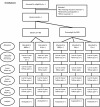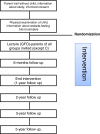A family-based intervention targeting parents of preschool children with overweight and obesity: conceptual framework and study design of LOOPS- Lund overweight and obesity preschool study
- PMID: 23072247
- PMCID: PMC3538526
- DOI: 10.1186/1471-2458-12-879
A family-based intervention targeting parents of preschool children with overweight and obesity: conceptual framework and study design of LOOPS- Lund overweight and obesity preschool study
Abstract
Background: As the rate of overweight among children is rising there is a need for evidence-based research that will clarify what the best interventional strategies to normalize weight development are. The overall aim of the Lund Overweight and Obesity Preschool Study (LOOPS) is to evaluate if a family-based intervention, targeting parents of preschool children with overweight and obesity, has a long-term positive effect on weight development of the children. The hypothesis is that preschool children with overweight and obesity, whose parents participate in a one-year intervention, both at completion of the one-year intervention and at long term follow up (2-, 3- and 5-years) will have reduced their BMI-for-age z-score.
Methods/design: The study is a randomized controlled trial, including overweight (n=160) and obese (n=80) children 4-6-years-old. The intervention is targeting the parents, who get general information about nutrition and exercise recommendations through a website and are invited to participate in a group intervention with the purpose of supporting them to accomplish preferred lifestyle changes, both in the short and long term. To evaluate the effect of various supports, the parents are randomized to different interventions with the main focus of: 1) supporting the parents in limit setting by emphasizing the importance of positive interactions between parents and children and 2) influencing the patterns of daily activities to induce alterations of everyday life that will lead to healthier lifestyle. The primary outcome variable, child BMI-for-age z-score will be measured at referral, inclusion, after 6 months, at the end of intervention and at 2-, 3- and 5-years post intervention. Secondary outcome variables, measured at inclusion and at the end of intervention, are child activity pattern, eating habits and biochemical markers as well as parent BMI, exercise habits, perception of health, experience of parenthood and level of parental stress.
Discussion: The LOOPS project will provide valuable information on how to build effective interventions to influence an unhealthy weight development to prevent the negative long-term effects of childhood obesity.
Trial registration: ClinicalTrials.gov NCT00916318.
Figures
References
-
- Obesity: preventing and managing the global epidemic. Report of a WHO consultation. World Health Organ Tech Rep Ser. 2000;894:1–253. i-xii. - PubMed
-
- Salbe AD, Weyer C, Lindsay RS, Ravussin E, Tataranni PA. Asessing risk factors for obesity between childhood and adolescence: Birth weight, childhood adiposity, parental obesity, insulin and leptin. Pediatrics. 2002;110(2 Pt 1):299–306. - PubMed
Publication types
MeSH terms
Associated data
LinkOut - more resources
Full Text Sources
Medical
Research Materials



